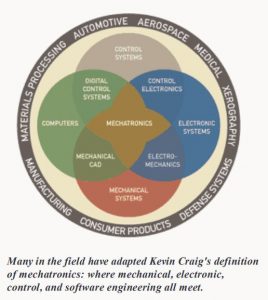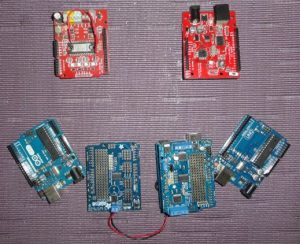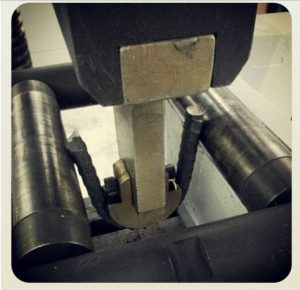“Who Owns Mechatronics?”, Feature Article, June 2008
Mechanical, electrical, control, and software engineers all play a vital role in building Mechatronics systems. But who will lead?
by Alan S. Brown,
Associate Editor
© 2008 by The American Society of Mechanical Engineers
Suddenly, mechatronics is everywhere. This year, North America, South America, Europe, Asia, and Oceania will all host major conferences devoted to the technology. Even more meetings will hold sessions on it. Engineers have mechatronics journals and can read mechatronics papers in journals that cover other fields. Many engineering schools include mechatronics courses, and three even offer bachelor’s degrees in the field.
This interest is not just academic. There is plenty of pull from industry. Consumer-products giant Procter & Gamble Co., for example, trains all new engineering hires in mechatronics. Companies as diverse as Swedish bearing manufacturer SKF Group and California-cool design firm IDEO embrace its precepts.
The term was coined nearly 40 years ago, in 1969, when engineer Tetsuro Mori combined the words “mechanical” and “electronic” to describe the electronic control systems that Yaskawa Electric Corp. was building for mechanical factory equipment.
Yet when engineers talk mechatronics today, that’s not all they’re talking about. The electromechanical control systems once designed for the factory floor have become ubiquitous. Mechatronics are everywhere around us, from computer hard drives and robotic assembly systems to washing machines, coffee makers, and medical devices. Electronics that control mechanical systems account for much of the value of the average automobile, managing everything from stability control and antilock brakes to climate control and memory-adjust seats.
Talk to anyone involved in mechatronics long enough and they will eventually say something like, “You can hardly build a mechanical system any more that doesn’t have electronics in it.”
So who will play the lead role in developing those mechatronics systems? Will it be the mechanical engineers, who design the moving parts? Will it be electrical engineers, whose chips and sensors are the heart of control? Will companies rely on software engineers, who give mechatronic devices their character? Or will it be engineers of some as-yet-undefined description? Who will own mechatronics?
The Bottom Line
“Mechatronics” means many things to many people, but when pressed, many reference a drawing shown by Kevin Craig, perhaps the nation’s foremost evangelist of mechatronic design. It consists of four overlapping circles: mechanical systems, electronic systems, control systems, and computers. Their overlaps form digital control systems, control electronics, electromechanics, and mechanical CAD. In the middle, their junction forms mechatronics.
“Mechatronics represents more than mechanical and electronics,” according to Craig, a professor of mechanical engineering who left Rensselaer Polytechnic Institute to start a mechatronics program at Marquette University. “Mechatronics is really all about design of any physical system, where you integrate controls, electronics, and computers from the very start of the design process.”
The emphasis on early design integration and parallel development is not coincidental. Last year, National Instruments Corp., a company whose software helps engineers develop mechatronic control systems, surveyed 30 machine builders around the world. “Of the 30, 29 said the complexity of their machines is going up drastically while time to market is going down,” said NI’s product manager, Todd Dobberstein.

Many in the field have adapted Kevin Craig’s definition of mechatronics: where mechanical, electronic, control, and software engineering all meet.
The same is true on the consumer side. “Everybody wants it faster, cheaper, smaller, and smarter, with more capacity and higher performance,” Craig said.
A study of 170 companies released by Boston-based technology think tank Aberdeen Group in February 2008 backs up both Craig and Dobberstein.
According to an Aberdeen analyst, Michelle Boucher, the best performers among the surveyed companies have changed the way they worked. Boucher’s top performers have a formal review process. More importantly, though, they do not schedule meetings based on time—every week, twice monthly—but on key events in the project timeline. Instead of wasting time in a meeting when nothing is happening, key players gather when it’s time to fit the pieces together.
They also believe in documentation. An engineer may answer a problem of vibration by adding a stiffener. In an integrated mechatronic process, however, that small mechanical change may increase the mass of the part; it also may affect how fast the control system ramps up motor speed and how long the part holds in place before returning. Formal documentation not only keeps everyone in the loop, but also lets them work on problems concurrently.
Many top mechatronic performers also use software that routes, tracks, and shares work. Most common are workflow tools, which automatically route work packages, warn about deadlines, and notify the right people of changes. Many companies make use of product data management tools to manage multidisciplinary bills of materials.
Design and project collaboration software are also popular. These applications help engineers visualize how systems work and are easy to mark up with questions and comments. “If you’re an electrical engineer, you don’t necessarily have easy access to CAD data, so this helps you see how the device is supposed to work,” Boucher said.
Adjectives Aside
But the question remains: Which engineers lead?
According to Peter Schmidt, a senior research engineer at Rockwell Automation’s Advanced Technology Group who teaches part-time with Craig at Marquette, “We’re all engineers and we’re doing engineering, period. I tell them not to worry about the adjective—mechanical, electrical, or whatever—in front of it.”
Schmidt started out as an electrical engineer. No surprise there. Rockwell Automation has long hired electrical and control engineers to design its machine control and factory automation systems. Many of the company’s engineers say they have been doing systems integration design and modeling-in short, mechatronics—for 20 years.
What separates mechatronics from systems integration design and modeling is not what engineers do, but how they do it, Schmidt said. “In the past, it was unheard of for a control company like Rockwell to have anything to do with the design of a machine,” he said. “It was proprietary. For companies like Procter & Gamble and Kimberly-Clark, those designs were a competitive advantage. They didn’t want us to know about what they were doing.
“Now, they’re trying to be more efficient, more cost-conscious. So instead of being called in after the fact, we go in and help them design it properly from the start.”
Then, tellingly, Schmidt added, “Because you’re in on the design phase, you have to work with different engineers— mechanical, electrical, computer programmers—and different companies.” It’s that multidisciplinary approach from concept through delivery that separates mechatronics from old-style control engineering at Rockwell.
Technology Driven Products Inc. of Loveland, Colo., is a very different company from Rockwell, but it has also embraced mechatronics. President Terry Precht calls it a virtual factory, combining design, manufacturing (usually 10,000 to 20,000 units per year), and depot repair services. The company’s products have ranged from Doppler radar golf swing analyzers and veterinary ophthalmoscopes to pump controllers and automated film drive systems. “Lately, we only design things we get to build, and prefer to build things that we design,” Precht said.
“Concurrent design is one of our advantages,” he explained. “Our manufacturing department is less than 50 feet away from engineering. The engineers do concept-level design, and then we get our manufacturing people involved in design review. They see if we can accomplish it functionally, and how we can embody some of those concepts.”
While some mechatronics teams like to run simulations, Precht prefers to prototype. “We like to build as fast as we can,” he said, although his firm also uses 3-D CAD and tools for electrical design. “You can answer certain questions from an actual model that you can’t get answered in a soft model,” he said.
For example, engineers make assumptions about efficiency or how fast they can remove heat using certain construction techniques. Prototyping determines whether they hit their mark. While electrical engineers design the circuitry, mechanical engineers determine the position of circuit board components to maximize heat exchange through the enclosure.
Project Leadership
“Our mechanical and electrical engineers are always working very closely together on these things,” Precht said. So who leads the project?
“It depends on the design,” Precht answered. Mechanical engineers handle designs that rely on mechanics, while electrical engineers handle projects with few moving parts. When Precht builds systems with complex moving parts, mechanical engineers write the control software since they understand how the devices should operate.
Precht tends to assign the most complicated projects to mechanical engineers. “If there are a lot of parts on the bill of materials, it requires a specialized skill set to keep organized and understand everything going on with mechanical parts and also processors and associated chips,” he said. The more complex the project, the more important it is to see the big picture.
Precht hires engineers trained in mechatronics at Colorado State University in nearby Fort Collins. “We have three graduates that went through Doctor Dave’s mechatronics course, and it was just obvious from the start how well they can work across a broad spectrum of projects compared with engineers who were classically trained,” Precht said. “They’re more readily adaptable and understand the basics of electronics, filters, and processors. Then they have that mechanical piece, the fundamentals that let them manage the packaging and heat in a device.”
“Doctor Dave” is David Alciatore, a professor of mechanical engineering who literally wrote the book on mechatronics, Introduction to Mechatronics and Measurement Systems, with co-author and professor emeritus Michael Histand. The first edition came out in 1999, and the book is now in its fourth edition.
Alciatore makes a strong case for mechanical engineers leading the way. “A good hands-on mechanical engineer trained in electronics makes a much better mechatronics engineer than an electrical engineer or computer engineer trained in mechanics later,” he said. When it comes to mechatronics projects, mechanical engineers are usually better able to troubleshoot software problems than electrical engineers can analyze how stiffness, friction, or clearance changes a machine.
Craig also believes that mechanical engineers should be mechatronics leaders. “We’re the broadest discipline and we build the physical systems,” he said. “What’s changed is that we incorporate electronic systems and controls into everything we do—not as an afterthought or an add-on—but as part of the design. You can’t have a mechanical engineer do his or her thing, then pass it on to an electrical or manufacturing engineer when it’s done.”
Because electronics has become such an integral part of mechanical design, mechanical engineers have had to learn to talk about sensors, actuators, processors, and code in the same breath as structural strength and materials. “We need to know how to use the devices electrical engineers create in our systems,” Craig said.
“Electrical and other engineers don’t have that experience, and they don’t crave that experience,” he said. They also don’t have time for it. According to Craig, electrical engineering programs are tightly focused and often specialized. “In some instances, electromagnetics and control engineering are not even required courses in their curriculum, and yet for us they are foundational,” he said. Alciatore, Precht, and Craig are all mechanical engineers, so it’s not surprising they think this way. At Rockwell Automation and other control system companies, electronics engineers have always led, Schmidt said.
“I like to think that an electrical engineer could do it all if he or she had to,” he said. He noted that electrical engineers go deeper into control theory than mechanical engineers do, and that expertise is needed when dealing with complex systems. For that reason, electrical engineers are likely to continue to lead the way at Rockwell. Then he added, “When dealing with customers on system design, it’s typically the customer’s mechanical engineers that we’re working with.”
At the Transportation Technology Center in Pueblo, Colo., which does testing for the American Association of Railroads, the leadership roles are fluid. “The individuals that end up filling the project manager role are usually those most comfortable with taking the leadership role and making presentations. This is often more a function of personality type than type of degree,” said executive director of engineering services Robert Florom.
Back to School
Right now, the question of who owns mechatronics—who will lead the development of next-generation electromechanical systems—often depends on where engineers work. Companies that make mechanical systems tend to let mechanical engineers lead; those that make electronics assign the lead to software and electrical engineers.
In the future, though, the issue may be decided by how colleges train the next generation of mechanical engineers. Right now, most schools teach controls, basic electronics, and programming as part of the mechanical engineering curriculum.
Alciatore takes that approach. “Our philosophy here is that all mechanical engineers should be trained so they can easily evolve into mechatronic engineers,” he said. In addition to the course work, Colorado State’s program also focuses on teaching students to work on teams, an essential for the multifunctional world of industrial design.
This comes together in a year-long senior capstone design course where teams design, build, and sometimes compete with sophisticated systems that have ranged from racing cars to search-and-rescue robots. Occasionally, a project draws an electrical engineer. “They don’t have as many projects, and they don’t usually build stuff,” Alciatore said. “They come over here to get experience on fun projects.”
Alciatore’s goal is to integrate more mechatronics into the traditional mechanical engineering curriculum.
At Marquette, Craig wants to revamp the curriculum entirely. “Mechatronics shouldn’t be a specialty in mechanical engineering, but all mechanical engineers should become mechatronic engineers, multidisciplinary engineers,” he said.
According to Craig, classical mechanical engineering has become a commodity skill. “We keep educating engineers that do what the rest of the world can do,” he said. “They can solve the problems, run the computer programs, do the nuts-and-bolts type stuff that our engineers can do. So what would you do if you were a corporation? Go to India or China and hire five engineers for the cost of one here.
“Our engineers need to graduate and contribute to solutions,” Craig said. “They need to be immediate, integrative, innovative, conceptual, and multidisciplinary. This is how I hear companies describe the modern engineer.” Mechatronics, he said, enables students to contribute from day one.
Craig’s goal at Marquette is to integrate courses so that electrical, control, and mechanical engineers learn how different disciplines use the same core knowledge to achieve different results. This is an uphill battle. When different disciplines teach a common control course, the content varies. “If an electrical engineer teaches, it’s very mathematical. If a mechanical engineer teaches, it’s very physical,” he said. Craig’s goal is to provide fundamental knowledge and modules that focus on discipline-specific applications. “We can’t just keep adding courses to the curriculum,” Craig said. “That just confuses the students. We have to show how we can integrate electronics and controls into modern mechanical systems. For mechanical engineers, this may not require in-depth knowledge of all these things, but it should at least give them the ability to speak to experts.”
Another approach is to offer a degree in mechatronics. So far, only three schools do that: California State University, Chico; North Carolina State University (a joint program at Raleigh and Asheville), and Colorado State University at Pueblo.
Pueblo is a small school, with 4,000 students and only 120 engineering majors. Until 2005, it offered only industrial engineering. The department chair, Jane Fraser, thinks that industrial engineering is an ideal platform for mechatronics because the focus is on bottom-line results rather than on gears or circuits. “It’s the closest you can get to a business degree and still be an engineer,” Fraser said.
Yet, like Craig, Fraser tells students that they’re engineers first, and mechanical, electrical, or other types of engineers second. “We’re trying to turn out students for more generalized engineering,” she said. The first two years of study are actually very generic, and students can easily transfer into industrial, mechanical, or civil engineering programs at any other state university.
The mechatronics program can be demanding, said Neb Jacsik, a Pueblo professor who started out as an electrical engineer and received his Ph.D. in industrial and systems engineering. “It’s extremely hard for many of the unwary students who had a little robot in school and thought they would just play with it some more and get a degree for that. Mechatronics does take a certain mindset, and it’s not just about playing with resistors or gears.”
Fraser originally opposed introducing mechatronics at Pueblo. “Originally, it sounded too gadget-oriented to me,” she said. She now believes mechatronics is where engineering is moving.
Manufacturing companies in her community are telling her the same thing. They want students trained to integrate electronics, controls, computers, and moving parts. For them, this is not just where engineering is going. It is where engineering has arrived.
Maybe one day mechatronics engineers will replace mechanical engineers. Or maybe all mechanical engineers will be mechatronics engineers.
In the meantime, though, it is a golden age for mechanical engineers who know how to add a sensor and program a processor to control moving parts.
http://www.memagazine.org/june08/features/whoowns/whoowns.html
© 2008 by The American Society of Mechanical Engineers






